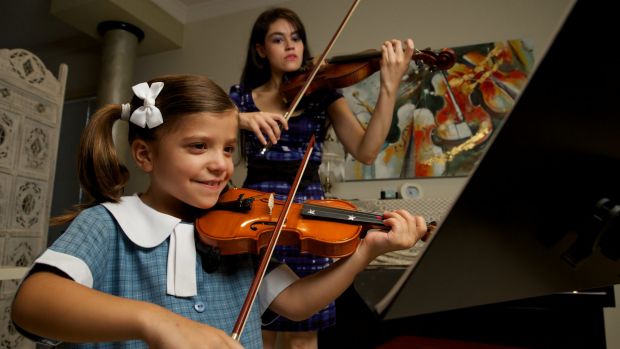
Six-year-old Natalia Zahorsky with her tutor Monica Rouvellas. Photo: Wolter Peeters
German violinist Christian Tetzlaff was performing one of Tchaikovsky’s concertos with the Cleveland Orchestra when had a complete memory lapse and froze for 30 seconds.
It was a sobering reminder that Tetzlaff, who took up the violin at age six and has since become an internationally celebrated classical musician, is still only human.
But there’s much expectation and pressure placed on aspiring concert performers. In the pursuit of perfection and the highly competitive seats in orchestras, many begin practicing for hours a day at a very young age.
Tetzlaff’s two-decade career has made him well aware of the mental and physical toll of relentless practice, and the high-pressure environment that can cause things such as his rare memory lapse.
It’s part of what shapes his strong belief that children are better off spending 20 minutes a day practicing, instead of being forced into hours of repetitious practice by their parents.
“I think there is something fundamentally wrong with instilling in children that only perfection on the instrument is the goal and will bring you somewhere,” says Tetzlaff, who is performing with the Sydney Symphony Orchestra in the Opera House next week.
“If you practice it like a horse you must lose some part of the joy of simply touching the violin and thinking you’re doing something that’s very beautiful.”
Natalia Zahorsky is six years old and is currently learning how to play the American folk song Go Tell Aunt Rhody on the violin.
Zahorsky has only been playing for a year, but her teacher, Monica Rouvellas, has many older students who have spent years building up their technique and spend hours a day practising for their HSC Extension Music performance examinations.
Rouvellas believes developing your technique is crucial for playing high-level repertoire, but says there’s a difference between quantity and quality of practice.
“The key take-away is that the amount of practice depends on the kids’ ability and willingness to improve themselves,” explains the multi-talented teacher.
While Rouvellas expects some of her older students to practice three to four hours a day, she spends time with them building an individualised practice routine and setting goals.
While achieving goals can be very rewarding, an overly ambitious or unrealistic goal can lead to unhealthy practice routines.
“Fear-based practice – fear of the teacher or parent’s opinion, or the player’s own desperate desire to succeed – kills the joy of playing,” says Janet Davies, who has been teaching at the Sydney Conservatorium of Music for 25 years.
Davies has lectured extensively on violin education and the Alexander Technique – a music methodology that emphasises the psychophysical state of a performer.
“Practising while stressed or tired is counter-productive, as is mind-numbing repetitious practice,” the Alexander Technique teacher says.
“There needs to be a balanced diet of practice material and the student needs to be creatively engaged in the process by continually envisaging the kind of player they want to be.”
